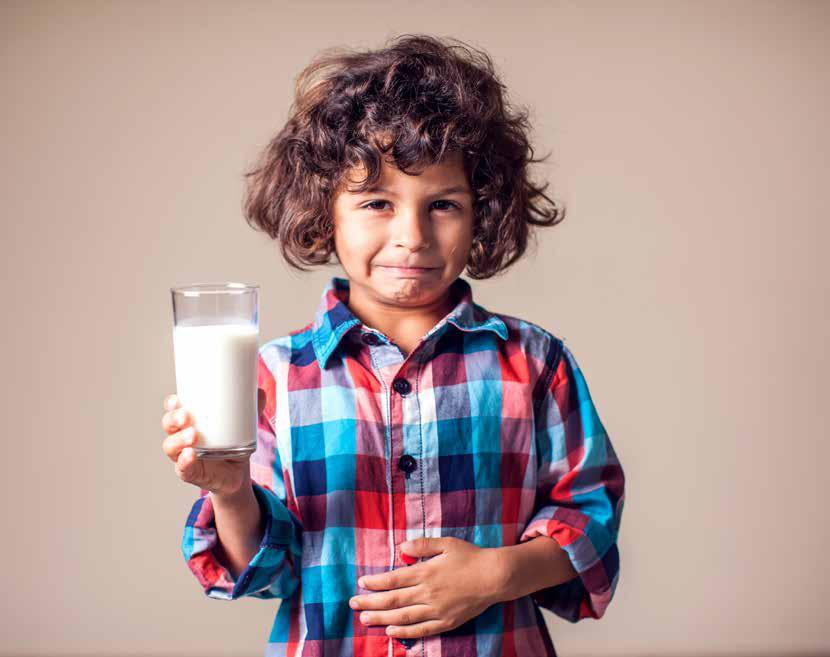
Lactose intolerance is the inability to properly digest the sugar (lactose) found in cow's milk and all other dairy products made from cow's milk. It is caused by producing too little of an enzyme called lactase in the small intestine. Some people will have lower-than-usual amounts of lactase but still be able to digest a certain amount of dairy without problems. However, once this tolerance limit is reached during a meal, you may begin to struggle to digest dairy. This results in a variety of symptoms that begin normally between half an hour and two hours after eating foods containing lactose. These symptoms can commonly include:
- Diarrhoea
- Nausea and sometimes vomiting
- Stomach cramps
- Bloating
- Gas
In most cases, people who become lactose intolerant begin life making enough lactase naturally. Infants, who rely fully on milk for all their nutrition, need lactase. As little ones grow and start substituting milk with various foods, the level of lactase they create falls, but usually stays at a high enough level to digest the dairy products often found in an average adult diet. However, for most people with lactose intolerance, their lactase production lowers dramatically by their early twenties, making it very challenging to digest milk products.
Secondary Lactose Intolerance
Sometimes, an injury to the small intestine can lead to the development of lactose intolerance. This can be in the form of a physical injury, illness or certain types of surgery. Conditions that have been linked to secondary lactose intolerance include digestive disorders like Crohn's disease, celiac disease, overgrowth of harmful bacteria in the gut and some internal gut infections. It's also possible to be born with lactose intolerance, although this is rare and is generally prevalent within the family already.
WHAT ARE THE RISK FACTORS?
This story is from the November 2022 edition of Mother, Baby & Child.
Start your 7-day Magzter GOLD free trial to access thousands of curated premium stories, and 9,000+ magazines and newspapers.
Already a subscriber ? Sign In
This story is from the November 2022 edition of Mother, Baby & Child.
Start your 7-day Magzter GOLD free trial to access thousands of curated premium stories, and 9,000+ magazines and newspapers.
Already a subscriber? Sign In

SUSTAINABLE FURNITURE FROM ETHNICRAFT
Check out the Belgian brand that's elevating homes in the region with a great ethos of sustainable luxury.

SETTING UP A GREAT HOME OFFICE
Working from home is on the rise, particularly among parents of younger children. How can you make that arrangement work for you?

A SPECIAL SEASONAL STAYCATION!
As the holidays draw near, Rixos Al Mairid Ras Al Khaimah has plenty to offer families looking for an extra special festive season.

A TROPICAL CELEBRATION IN MAURITIUS
For something different this Christmas, here are two incredible tropical resorts that your family will love.

HOW TO COMMUNICATE WITH YOUR CHILD'S TEACHERS
We look at some tips and strategies to help you communicate effectively and confidently with your child’s teachers.

LEARNING TEAMWORK THROUGH OUTDOOR PLAY
This month, the educators at Dibber International Nurseries discuss why playtime outdoors is essential for teaching teamwork to young learners.

UNDERSTANDING MOODY TEENAGERS
Puberty goes hand in hand with mood swings. As a parent, what can you do to help?

FESTIVE FUN FOR FAMILIES
The festive season is a time of joy, togetherness and celebration - the perfect opportunity to try some new activities together as a family.

THE POWER OF SAYING "LET'S TRY..."
Having the right words on hand is a huge part of parenting. This is a phrase that helps everyone feel like they're on the same side.

STRATEGIES FOR DINING OUT WITH YOUNG KIDS
Eating out can be tricky when you have younger children. Here are five things that may help!